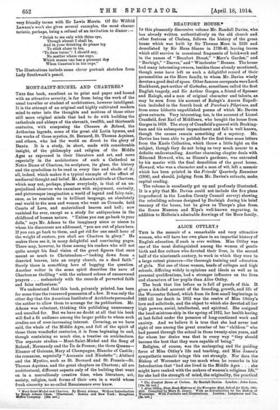MONT-SAINT-MICHEL AND CHARTRES.* THIS fine book, excellent as to print
and paper and bound with an attractive severity, is far from being the work of the usual traveller or student of architeotirre, however intelligent. It is the attempt of an original and highly cultivated modern mind to enter into the thoughts and motives of those other still more original minds that had to do with building the cathedrals and abbeys of the eleventh, twelfth, and thirteenth centuries, with composing the Chanson de Roland, the Arthurian legends, some of the great old Latin hymns, and the works of those mystics, St. Bernard, St. Thomas Aquinas, and others, who led the world on direct to the glory of Dante. It is a study, in abort, made with considerable insight, of the philosophy and religion of the Middle Ages as expressed in their literature and art, and more especially in the architecture of such a Cathedral as Notre Dame of Chartres, its sculpture, its glass, the history and the symbolism to be read in every line and shade of it ; all, indeed, which makes it a typical example of the effect of mediaeval thought and belief. Mr. Adams's attitude at Chartres, which may not, perhaps, please everybody, is that of an un- prejudiced observer who examines with enjoyment, curiosity, and picturesque imagination a world of legend and fairy-tale ; once, as lie reminds us in brilliant language, an absolutely real world to the men and women who went on Crusade, held Courts of Love, and materialized heaven and hell ; now vanished for ever, except as a study for antiquarians in the childhood of human nature. "Unless you can go back to your dolls," says Mr. Adams to the imaginary niece or nieces to whom his discourses are addressed, "you are out of place here. If you can go back to them, and get rid for one small hour of the weight of custom, you shall see Chartres in glory." He makes them see it, in many delightful and convincing pages. There may, however, be those among his readers who will not quite accept his final vision of the great figures that once meant so much to 'Christendom—" looking down from a deserted heaven, into an empty church, on a dead faith." Surely there is something here of begging the question. Another writer in the same spirit describes the nave of Chartres as thrilling" with the unheard echoes of unanswered prayers . . . melancholy with the records of perverted faith and false enthusiasm."
We understand that this book, privately printed, has been for some time the treasured possession of a few. It was only the other day that the American Institute of Architects persuaded the author to allow them to arrange for its publication. Mr. Adams was reluctant, thinking this publishing unnecessary and uncalled for. But we have no doubt at all that his book will find a fit audience among the larger public to whom such studies are of ever-increasing interest. Covering, as we have said, the whole of the Middle Agee, and full of the spirit of those three wonderful centuries, it is from beginning to end, though containing eo much else, a treatise on architecture. The separate studies —Mont-Saint-Michel and the Song of Roland; Normandy and the lie de France; the three Queens— Eleanor of Guienne, Mary of Champagne, Blanche of Castile; the romances, especially "Aneassin and .Nicolette"; Abdlard and the Mystics, such as St. Bernard and St. Francis—St. Thomas Aquinas, and the great chapters on Chartres; all are architectural, different aspects only of the building that' went on in a marvellously creative time, when literature, art, society, religion, took forma of their own in a world whose fresh sincerity no so-called Renaissance ever knew.
• Mena-Saint-Michel and Chartres. By Henry Adam.. With an Introduction 1,4tEnitpla Adams Cram. ' Illustrated. Boston and New York: Houghton Company. [25.. net.]










































 Previous page
Previous page